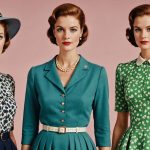Historical Foundations of UK Fashion and Women’s Style
Exploring UK fashion history reveals how early 20th-century movements profoundly shaped women’s style. The shift from restrictive Victorian garments to more practical and expressive attire marked a turning point. The 1920s, for instance, introduced flapper dresses and looser silhouettes, reflecting new social freedoms. This period established a foundation for continuous evolution in women’s fashion.
The impact of post-war Britain in the 1950s and 1960s cannot be overstated. After the austerity of World War II, British women embraced bold, innovative looks that diverged sharply from previous norms. Designers began experimenting with more daring cuts, and youth culture emerged as a powerful fashion driver. This era fueled a revolution in British women’s wear characterized by playful patterns, shorter hemlines, and a spirit of rebellion.
Also to see : Top tips for uk women to craft a stylish and functional capsule wardrobe
Integral to this evolution were UK fashion icons who carved global influence through their distinctive styles. Figures like Mary Quant popularized the miniskirt, while models such as Twiggy embodied the era’s youthful exuberance. These fashion icons not only mirrored societal shifts but also propelled British fashion onto the international stage, cementing the UK’s role as a style innovator.
Influential British Designers and Their Impact
British fashion designers have significantly shaped global style narratives, blending heritage with innovation. Vivienne Westwood’s punk revolution in the 1970s challenged conventional fashion by introducing rebellious, boundary-pushing designs that became cultural symbols beyond clothing. Her legacy embodies a fearless approach to personal expression, inspiring countless designers and individuals alike to view fashion as a form of protest and identity.
In parallel : Unlocking vintage chic: a guide for women to blend retro styles with contemporary uk fashion
Equally transformative, Alexander McQueen offered an avant-garde perspective, merging theatricality with craftsmanship. His bold, often provocative runway shows explored themes of life, death, and beauty, redefining the possibilities of personal style. McQueen’s influence extends beyond garments; it encourages wearers to embrace complexity and storytelling in their wardrobe.
Other key British designers have also contributed to the evolving dialogue on fashion and self-expression, reinforcing the UK’s role as a powerhouse of creativity. Their collective designer influence underscores how British fashion continues to inspire and redefine personal style narratives worldwide, showing that fashion is not just about aesthetics but an impactful, meaningful language of identity.
Subcultures and Street Style as Catalysts for Self-Expression
Subcultures like mod fashion, punk, and Britpop have played pivotal roles in shaping UK subcultures, especially among women seeking unique self-expression. These movements fostered a strong sense of individualism, encouraging women to break free from mainstream fashion norms. Mod fashion, with its sharp, tailored styles and bold patterns, gave rise to a confident, sophisticated female look that blended rebellion with refinement. Punk introduced a raw, defiant edge—think leather jackets, ripped clothing, and safety pins—emphasising anti-establishment attitudes and personal freedom.
Youth-driven street style continues to evolve, driven by younger generations who adapt and reinterpret these influences to express their identities in everyday life. Women’s street style today embodies this legacy, mixing elements from past subcultures with contemporary trends, highlighting authenticity and creativity.
The enduring impact of UK subcultures extends beyond national borders, inspiring global women’s style movements. From vibrant streetwear scenes to high fashion runways, the spirit of mod, punk, and Britpop remains a powerful catalyst for fresh, diverse forms of self-expression. This continual reinvention helps maintain a dynamic dialogue between history, culture, and personal identity.
Contemporary Trends and Global Reach
The modern UK fashion scene continues to shape women’s fashion trends not only locally but on a global scale. UK designers have adeptly blended traditional British elements with avant-garde aesthetics, creating a style that resonates internationally. This fusion invites women to adopt unique personal styles influenced by UK fashion’s emphasis on individuality and boldness.
Social media plays a pivotal role in expanding the global influence of UK fashion. Platforms like Instagram and TikTok showcase UK-based looks, enabling rapid dissemination of trends. Celebrities and influencers wear iconic UK styles, boosting visibility and inspiring women worldwide to incorporate these motifs into their wardrobes.
For example, the UK’s penchant for mixing punk-inspired accessories with high street wear has been embraced in cities from Tokyo to New York. This adoption reflects the adaptability of UK fashion motifs, which merge effortlessly with local trends. The impact is evident in the rise of tailored yet edgy pieces, often inspired by UK collections, found in international stores.
By weaving tradition with innovation, modern UK fashion not only sets new women’s fashion trends but also fosters a cultural exchange that empowers women everywhere to explore diverse, inspired wardrobes.
Shifts in Self-Expression and Individuality
UK fashion increasingly champions self-expression as a vital element of personal identity. This shift empowers individuals to weave their unique narratives through clothing choices, fostering a strong sense of individuality. Rather than conforming to rigid dress codes, modern British trends embrace authentic creative self-presentation, encouraging wearers to showcase diverse facets of their personality.
The UK’s fashion industry actively promotes personal style empowerment, giving freedom to mix traditional and contemporary influences. For example, combining punk-inspired elements with sleek tailoring allows people to craft distinct stories that reflect their background and values. This storytelling through style resonates authentically with the wearer and observers alike, making fashion a tool for communication rather than mere aesthetics.
Importantly, the UK fashion scene reflects a commitment to inclusive and diverse representation. Models, designers, and campaigns now portray a broader spectrum of ethnicities, body types, and gender identities. This inclusivity not only broadens the definition of beauty but also validates and uplifts varied forms of self-expression, nurturing a more welcoming and relatable fashion environment.
By embracing these evolutions, UK fashion inspires individuals to confidently express their true selves while celebrating the richness of diversity.










